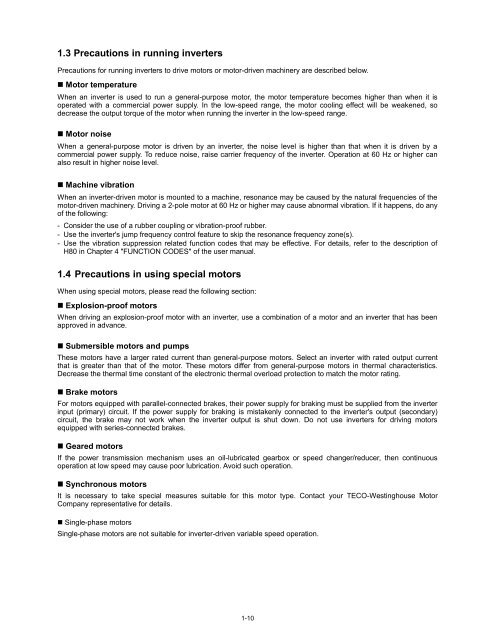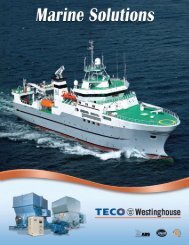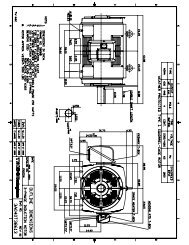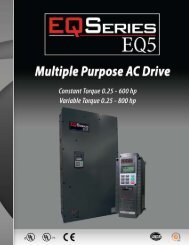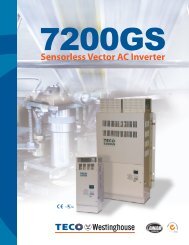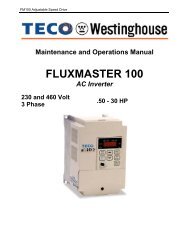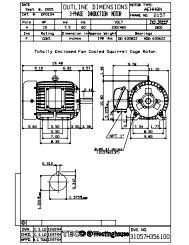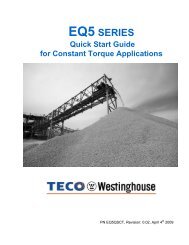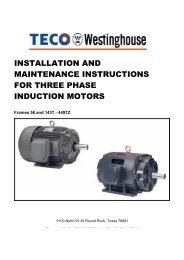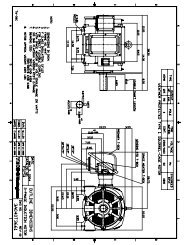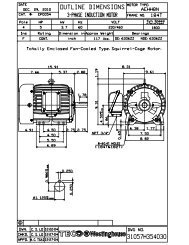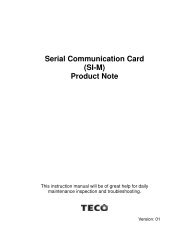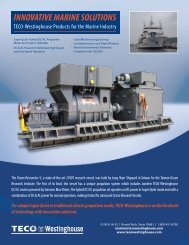EQ7 Series Instruction Manual - TECO-Westinghouse Motor Company
EQ7 Series Instruction Manual - TECO-Westinghouse Motor Company
EQ7 Series Instruction Manual - TECO-Westinghouse Motor Company
You also want an ePaper? Increase the reach of your titles
YUMPU automatically turns print PDFs into web optimized ePapers that Google loves.
1.3 Precautions in running inverters<br />
Precautions for running inverters to drive motors or motor-driven machinery are described below.<br />
• <strong>Motor</strong> temperature<br />
When an inverter is used to run a general-purpose motor, the motor temperature becomes higher than when it is<br />
operated with a commercial power supply. In the low-speed range, the motor cooling effect will be weakened, so<br />
decrease the output torque of the motor when running the inverter in the low-speed range.<br />
• <strong>Motor</strong> noise<br />
When a general-purpose motor is driven by an inverter, the noise level is higher than that when it is driven by a<br />
commercial power supply. To reduce noise, raise carrier frequency of the inverter. Operation at 60 Hz or higher can<br />
also result in higher noise level.<br />
• Machine vibration<br />
When an inverter-driven motor is mounted to a machine, resonance may be caused by the natural frequencies of the<br />
motor-driven machinery. Driving a 2-pole motor at 60 Hz or higher may cause abnormal vibration. If it happens, do any<br />
of the following:<br />
- Consider the use of a rubber coupling or vibration-proof rubber.<br />
- Use the inverter's jump frequency control feature to skip the resonance frequency zone(s).<br />
- Use the vibration suppression related function codes that may be effective. For details, refer to the description of<br />
H80 in Chapter 4 "FUNCTION CODES" of the user manual.<br />
1.4 Precautions in using special motors<br />
When using special motors, please read the following section:<br />
• Explosion-proof motors<br />
When driving an explosion-proof motor with an inverter, use a combination of a motor and an inverter that has been<br />
approved in advance.<br />
• Submersible motors and pumps<br />
These motors have a larger rated current than general-purpose motors. Select an inverter with rated output current<br />
that is greater than that of the motor. These motors differ from general-purpose motors in thermal characteristics.<br />
Decrease the thermal time constant of the electronic thermal overload protection to match the motor rating.<br />
• Brake motors<br />
For motors equipped with parallel-connected brakes, their power supply for braking must be supplied from the inverter<br />
input (primary) circuit. If the power supply for braking is mistakenly connected to the inverter's output (secondary)<br />
circuit, the brake may not work when the inverter output is shut down. Do not use inverters for driving motors<br />
equipped with series-connected brakes.<br />
• Geared motors<br />
If the power transmission mechanism uses an oil-lubricated gearbox or speed changer/reducer, then continuous<br />
operation at low speed may cause poor lubrication. Avoid such operation.<br />
• Synchronous motors<br />
It is necessary to take special measures suitable for this motor type. Contact your <strong>TECO</strong>-<strong>Westinghouse</strong> <strong>Motor</strong><br />
<strong>Company</strong> representative for details.<br />
• Single-phase motors<br />
Single-phase motors are not suitable for inverter-driven variable speed operation.<br />
1-10


